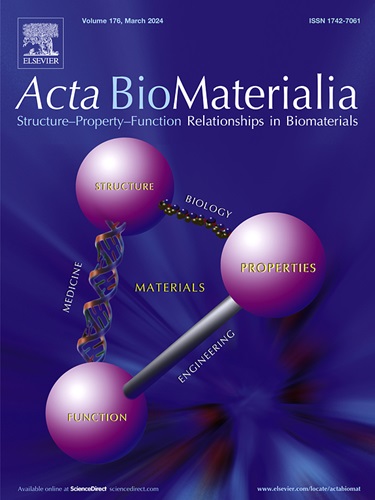Cu-Mn nanocomposite for enhanced tumor cuproptosis achieved by remodeling the tumor microenvironment and activating the antitumor immunogenic responses
IF 9.4
1区 医学
Q1 ENGINEERING, BIOMEDICAL
引用次数: 0
Abstract
Cuproptosis is a newly discovered mode of cell death, which is caused by excess copper and results in cell death via the mitochondrial pathway. However, the complex tumor microenvironment (TME) is characterized by many factors, including high levels of glutathione and lack O2, limit the application of traditional cuproptosis agents in antitumor therapy. Herein, we report a hyaluronic acid modified copper-manganese composite nanomedicine (CMCNs@HA) to remodel the TME and facilitate efficient cuproptosis in tumor. The integration of CuO2 and MnO2 into CMCNs@HA endows this nanoplatform to generate O2 and deplete GSH in tumor site, ensuring the environment is beneficial to the cuproptosis of tumor. The glutathione (GSH) depletion process is accompanied by the release of Mn2+ ions. The released Mn2+ ions improve the cuproptosis through efficient chemodynamic therapy and initiate immune response via activating the cyclic GMP-AMP synthase-stimulator of interferon genes (cGAS-STING) pathway, which significantly suppresses tumor growth and inhibits tumor metastases. In addition, the Mn2+ ions release process enables this nanoplatform to work as activable T1 contrast agent to achieve accurate tumor diagnosis. This functionally complementary composite metal nanomaterial may provide effective ideas regarding the application of cuproptosis in designing tumor therapeutic regimens.
Statement of significance
Cuproptosis in combination with cGAS-STING offers significant potential for tumor treatment. Here, we constructed TME responsive copper-manganese composite nanomaterials (CMCNs@HA) to augment tumor cuproptosis. GSH depletion, hypoxia relief, and effective chemodynamic therapy caused by CMCNs@HA facilitate the progression of cuproptosis. Besides, CMCNs@HA successfully initiate immune response via activating the cyclic GMP-AMP synthase-stimulator of interferon genes pathway and significantly inhibits tumor metastases. Simultaneously, released Mn2+ ions provide real-time magnetic resonance imaging (MRI) signal changes, enabling accurate tumor diagnosis and monitoring of the therapeutic process.

求助全文
约1分钟内获得全文
求助全文
来源期刊

Acta Biomaterialia
工程技术-材料科学:生物材料
CiteScore
16.80
自引率
3.10%
发文量
776
审稿时长
30 days
期刊介绍:
Acta Biomaterialia is a monthly peer-reviewed scientific journal published by Elsevier. The journal was established in January 2005. The editor-in-chief is W.R. Wagner (University of Pittsburgh). The journal covers research in biomaterials science, including the interrelationship of biomaterial structure and function from macroscale to nanoscale. Topical coverage includes biomedical and biocompatible materials.
 求助内容:
求助内容: 应助结果提醒方式:
应助结果提醒方式:


